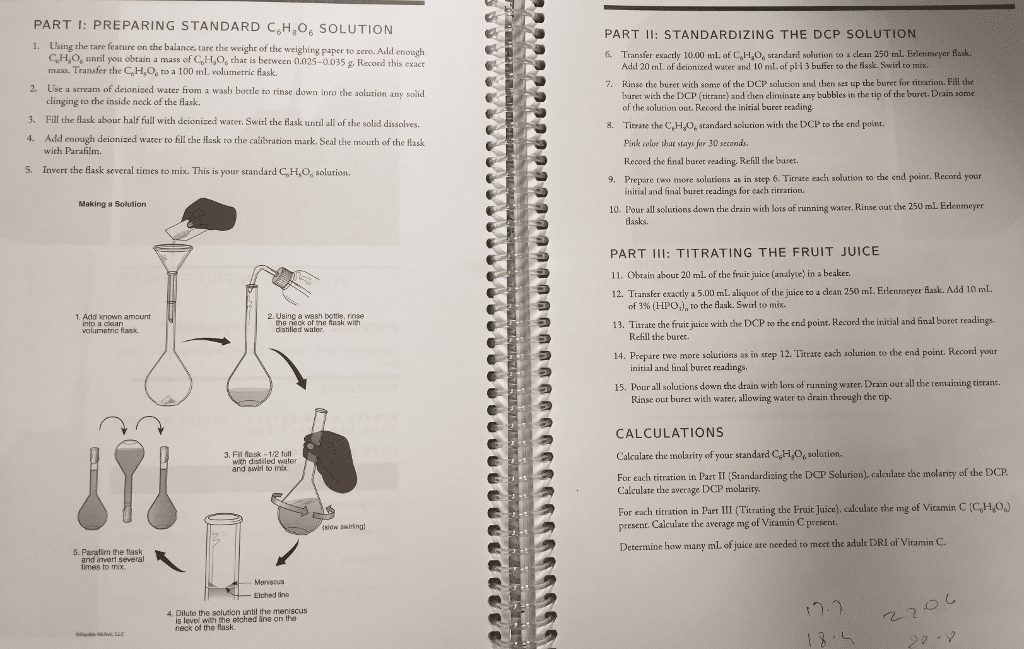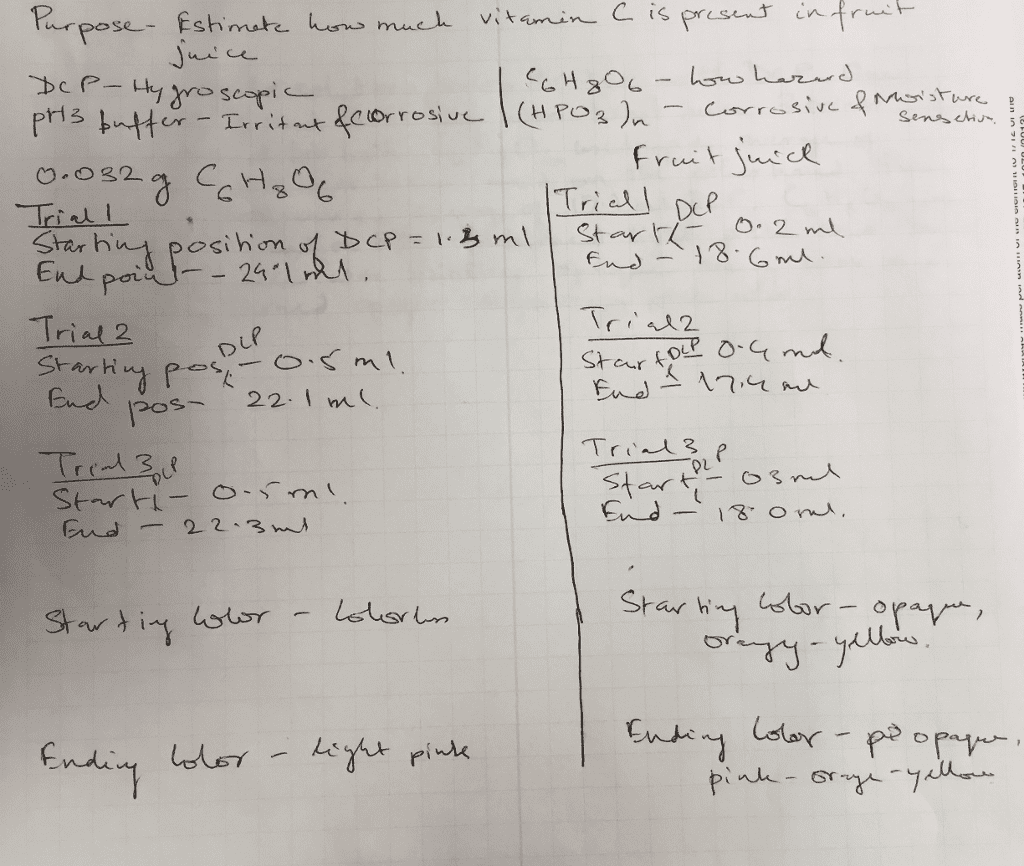If you were to over-titrate your calcium solutions in Part B of this lab:a.Would the calculated molarity of EDTA be too high or too low? Explain.
b.Would the calculated molarity of calcium unknown in part C be too high or too low? Explain.
Part B Setup: Complete the following steps, after reading page 6 on how to use volumetric glassware:1.You should have already used a 500 mLvolumetric flaskto prepare an approximately 0.010 M solution of Na2EDTA (Part 1).2.Clean the buret carefully and rinse it two or three times with small amounts (~5mL) of your EDTA solution. Hint; use a clean, dry, labeled beaker to pour solution into the buret. Make sure you rinse through the tip and that no air bubbles are in the tip. Mount the buret on a ring stand using buret clamps. Fill the buret with your EDTA solution nearly to the top mark (to somewhere between the 0 and 5 mL marks for every trialâDO NOT waste time filling the buret to exactly 0.00 mL!). The EDTA is the titrant,the solution added during the titration. Chemistry 161 Lab5Bozlee -Based on S. Critchlow Winter 2018page 4of 11Green River Community College Standardization of the EDTA solution:4.Record the exact reading of the liquid level (bottom of the meniscus) in the buret, recording to the nearest 0.01 mL. This is your initial volume. Note:The burets can be read to a precision of at least +/-0.02 mL. Be sure that all of your readings are precise and consistent.Check with your instructor if you are unclear whether your buret readings are correct.5.In a clean dry beaker, take about 50 mL of standard 0.01000 MCa2+solution; do not take more than this at a time. This is enough to do two trials; if only doing one trial take no more than 30 mL. After proper rinsing, pipet 20.00 mLof this standard Ca2+solution into a 125 mL Erlenmeyer flask. The volumetric pipet tip should NOT be âblown out.â Add about 25 mL of deionized water to the flask.The volume of water is not critical.6.Add a few drops (~6) of indicatorand one full dropperfulof the buffer solutionto the solution in the Erlenmeyer flask.7.Place the stir bar in the flask, place the flask on the stir plate, and set the control for gentle stirring. Or, if you have a good swirling technique with the Erlenmeyer flask, the stir bar and plate is unnecessary. It is essential that the solutions be continually stirred or swirled while titrating.8.What net volume of titrant should be required for the standard trials? You should be able to predict this by calculation!Slowly add your EDTA solution from the buret until the endpoint is reached. The endpointin this titration is the point at which the solution in the Erlenmeyer flask first turns a distinct blue. The color change of the indicatorat the endpoint signals that the equivalence pointhas been reached, where the reactants are in the correct stoichiometric ratio to completely react. As you near the endpoint, add EDTA drop by drop to avoid âovershooting the endpoint.â Record to the nearest 0.01 mL the exact liquid level of EDTA in the buret (your final volume), and calculate the net volume of EDTA used in the titration by subtracting the initial volume from the final volume of EDTA.9.Discard your waste in the appropriate container, using only a very small amount of DI water as the first rinse. Then rinse out your Erlenmeyer flask thoroughlywith several portions of DI water at your sink. Refill the buret (always to between 0 and 5 mL) if you will do another trial. 10.Repeat steps 4-9 two more times, using a fresh aliquot(measured sample) of standard Ca+2solutioneach time. Ideally your replicate titrations should agree within 0.2 mL
If you were to over-titrate your calcium solutions in Part B of this lab:a.Would the calculated molarity of EDTA be too high or too low? Explain.
b.Would the calculated molarity of calcium unknown in part C be too high or too low? Explain.
Part B Setup: Complete the following steps, after reading page 6 on how to use volumetric glassware:1.You should have already used a 500 mLvolumetric flaskto prepare an approximately 0.010 M solution of Na2EDTA (Part 1).2.Clean the buret carefully and rinse it two or three times with small amounts (~5mL) of your EDTA solution. Hint; use a clean, dry, labeled beaker to pour solution into the buret. Make sure you rinse through the tip and that no air bubbles are in the tip. Mount the buret on a ring stand using buret clamps. Fill the buret with your EDTA solution nearly to the top mark (to somewhere between the 0 and 5 mL marks for every trialâDO NOT waste time filling the buret to exactly 0.00 mL!). The EDTA is the titrant,the solution added during the titration. Chemistry 161 Lab5Bozlee -Based on S. Critchlow Winter 2018page 4of 11Green River Community College Standardization of the EDTA solution:4.Record the exact reading of the liquid level (bottom of the meniscus) in the buret, recording to the nearest 0.01 mL. This is your initial volume. Note:The burets can be read to a precision of at least +/-0.02 mL. Be sure that all of your readings are precise and consistent.Check with your instructor if you are unclear whether your buret readings are correct.5.In a clean dry beaker, take about 50 mL of standard 0.01000 MCa2+solution; do not take more than this at a time. This is enough to do two trials; if only doing one trial take no more than 30 mL. After proper rinsing, pipet 20.00 mLof this standard Ca2+solution into a 125 mL Erlenmeyer flask. The volumetric pipet tip should NOT be âblown out.â Add about 25 mL of deionized water to the flask.The volume of water is not critical.6.Add a few drops (~6) of indicatorand one full dropperfulof the buffer solutionto the solution in the Erlenmeyer flask.7.Place the stir bar in the flask, place the flask on the stir plate, and set the control for gentle stirring. Or, if you have a good swirling technique with the Erlenmeyer flask, the stir bar and plate is unnecessary. It is essential that the solutions be continually stirred or swirled while titrating.8.What net volume of titrant should be required for the standard trials? You should be able to predict this by calculation!Slowly add your EDTA solution from the buret until the endpoint is reached. The endpointin this titration is the point at which the solution in the Erlenmeyer flask first turns a distinct blue. The color change of the indicatorat the endpoint signals that the equivalence pointhas been reached, where the reactants are in the correct stoichiometric ratio to completely react. As you near the endpoint, add EDTA drop by drop to avoid âovershooting the endpoint.â Record to the nearest 0.01 mL the exact liquid level of EDTA in the buret (your final volume), and calculate the net volume of EDTA used in the titration by subtracting the initial volume from the final volume of EDTA.9.Discard your waste in the appropriate container, using only a very small amount of DI water as the first rinse. Then rinse out your Erlenmeyer flask thoroughlywith several portions of DI water at your sink. Refill the buret (always to between 0 and 5 mL) if you will do another trial. 10.Repeat steps 4-9 two more times, using a fresh aliquot(measured sample) of standard Ca+2solutioneach time. Ideally your replicate titrations should agree within 0.2 mL


